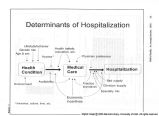| OCR Text |
Show affect hospitalization rates, but it is important to consider the other factors that might confound the relationship of interest. Some can be controlled at least in part by appropriate analyses; others require careful consideration when interpreting results. Specific Uses of Hospital Discharge Data for Population-based Assessment Measuring Occurrence of Health Conditions Estimates of the frequency of occurrence of specific health conditions are one of the most basic needs for health assessment. Hospital discharge data are an attractive source of occurrence estimates for certain types of conditions and in certain situations. For many conditions, death rates are the only available measure of occurrence outside of special epidemiologic studies. For some conditions, self-reported prevalence may be available from periodic surveys. Death rates are not useful for many conditions that cause substantial morbidity but infrequently cause death (e.g. asthma, intervertebral disc disease, hip fracture, and pelvic inflammatory disease). For other conditions, while death data may be relevant, the number of deaths may be insufficient for analyses of smaller populations (e.g., of counties or health districts). Hospital discharge data may allow such analyses because of the greater number of events for some conditions (Table 1, page 34). For other diseases, death occurs only after many years of illness, so that trends based on death rates reflect disease acquisition that occurred years ago. Hospital discharge rates may provide estimates that are closer to current incidence (Feinleib, Havlik, Gillum et al., 1989). Particularly at the national level, using data from the National Hospital Discharge Survey, hospital discharge data have been used to estimate occurrence for a number of conditions (Feinleib et al., 1989; Rolfs, Galaid & Zaidi, 1992; Bloom & Kroch, 1993; Taylor, Deyo, Cherkin, Krents, 1994; Weiss, Gergen, Hodgson, 1992). Hospital discharge and death data have been used in combination to estimate and track incidence of myocardial infarction (Hammar, Nerbrand, Ahlmark, Tibblin et al., 1991). Several of the Healthy People 2000 objectives are tracked at the national level using hospital discharge data (U.S. Public Health Service, 1990). As will be discussed in more detail later in this paper, most population-based studies of variation in hospital discharge rates have been interested in utilization rather than health status.2 Those studies often found that factors other than need for care explained much of the observed variation among areas. That finding suggests caution in using hospital discharge rates to estimate and track disease occurrence. However, those studies tended to examine only a few conditions and focused primarily on surgical procedures rather than medical diagnoses. In some settings and for some conditions, hospitalization rates have correlated well with other indicators of occurrence, such as mortality (Lanska & Kryscio, 1994; Miller, Miller, Fireman & Black, 1994). An example of using Utah hospital discharge data to estimate occurrence of several health conditions is discussed below. Hospitalizations for Diseases Related to Lifestyle or Behavior Lifestyle and behavioral risk factors, such as tobacco use, diet, exercise, misuse of alcohol or illicit drugs, sexual behavior, and violence are responsible for at least half of all premature deaths of Americans. It has been suggested that those behaviors and lifestyles, not the traditional medical causes (heart disease, cancer, etc.), are the true "causes" of death and disability (McGinnis & Foege, 1993). To call attention to the additional health burden due to those behavioral causes, the Utah Department of Health (UDOH) published a report on hospitalizations for conditions and diseases that are related to lifestyle and behavior (Health Data Committee, 1995). The conditions were identified using published estimates of attributable risks that were developed primarily for mortality (McGinnis et al. 1993; Brownson, Remington & Davis, 1993; CDC, 1987; Amler & Dull, 1987; USPHS, 1988). Hospitilizations for those conditions were identified using the International Classification of Diseases, Ninth Revision (ICD-9) codes grouped to be compatible with National Center for Health Statistics (NCHS) reports from the National Hospital Discharge Survey (NHDS) (Graves, 1994). All hospitalizations of Utah residents at hospitals within Utah were included. Rates were compared with national data and among the twelve local health districts. Table 2 (see page 34) presents data on selected conditions included in that report. Figure 2 (see page 36) presents the age and sex-specific rates that were included in that report graphically for one condition, ischemic heart disease. Why are Utahns Hospitalized: Leading Reasons for Hospitalization by Age and Sex The UDOH is also preparing a report on the leading reasons for hospitalization, patterned after a similar report on leading causes of death (Office of Surveillance Analysis, 1994). This report will support one of the data needs suggested by the Assessment Protocol for Utah's Health: An Annual Review 1995 27 |


























































































































































